- Sustainability
- DE&I
- Pandemic
- Finance
- Legal
- Technology
- Regulatory
- Global
- Pricing
- Strategy
- R&D/Clinical Trials
- Opinion
- Executive Roundtable
- Sales & Marketing
- Executive Profiles
- Leadership
- Market Access
- Patient Engagement
- Supply Chain
- Industry Trends
2021 Pharm Exec Top 50 Companies
Pharm Exec’s latest listing of the top global biopharma sales producers captures the critical business and public health balancing act that was required in the Year of COVID—reinforcing the staying power of building brand value while championing medical innovation.
Source: mbolina/stock.adobe.com
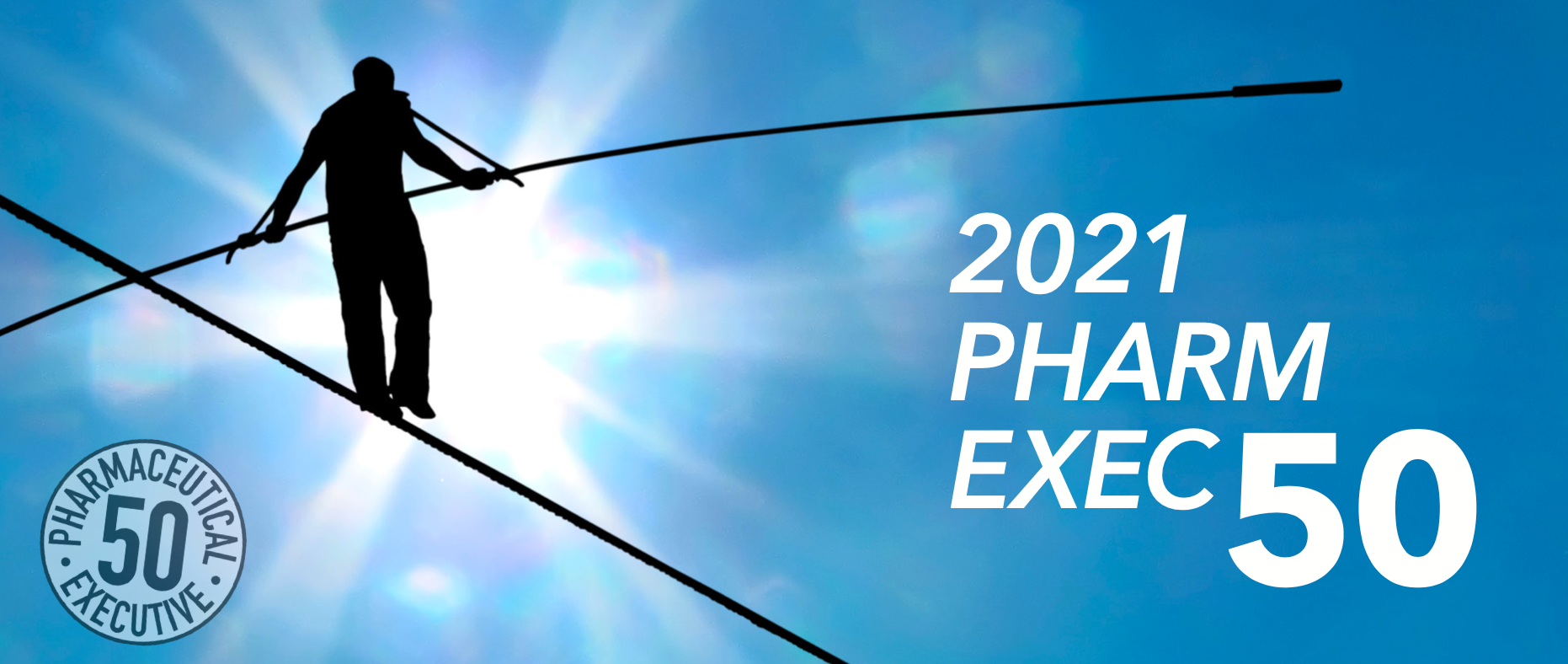
Sitting roughly at the halfway point of 2021, a global pandemic abating in the US and elsewhere, and communities antsy to settle back into “normal” life routines again can make a peek back into 2020 not the most fruitful exercise for the mind. The emotions of those times remain close—and the easy and quick fix may still be, can we just keep it out of our consciousness for the time being? But, of course, along with all the unrest and tragic and divisive events that occurred simultaneously, and the quest for needed change in those areas, recognizing how enterprises such as the biopharmaceutical industry performed and responded during the Year of COVID—in bottom-line business and contributions to the greater good—is important to chronicle and remember.
That’s what Pharm Exec is doing again this year, with an eye on connected current trends, in presenting its annual listing of the top 50 global biopharma players based on prescription drug sales. The data is again provided in partnership with life sciences market intelligence firm Evaluate Ltd, and also includes company R&D spending totals. The rankings, our 21st, are constructed from the most recent full-year drug revenue tallies, a time span greatly influenced by the COVID-19 pandemic. The crisis created a tightrope many pharma companies had never faced before. Challenged on one end to maintain and grow commercial franchises and keep access and development channels open while safeguarding employees and operations; and then on the other, the call to band together to turn back a deadly and difficult to infiltrate virus through vaccines, treatments, outreach, and other interventions. As part of our June Pharma 50 coverage, we profile such efforts from five organizations (Pfizer, Moderna, J&J, Regeneron, and Gilead), detailing their success stories in advancing COVID-driven science and innovation.
Amid the rush to develop and deliver effective vaccines and drugs for COVID, demands on companies were many. They included new work-from-home policies, supply chain and logistics issues caused by closed borders, and changing dynamics in patient and healthcare provider engagement. Not surprisingly, in a survey of pharma C-suite executives conducted by Model N, 58% said that the pandemic had the biggest impact on the way their companies managed revenue.
As market cap numbers illustrated in 2020, overall growth during the pandemic was swayed significantly by COVID-related factors, but not in all cases. For example, according to figures compiled by GlobalData, AbbVie, which doesn’t have any notable COVID products, enjoyed the biggest year-over-year growth in market cap, at 44.4%, among the top 10 drugmakers with the largest market caps at the end of 2020. More in line with events of the day, Eli Lilly, which in February gained emergency use authorization for its COVID antibody cocktail, saw a 28% year-over-year market cap increase. Roche, with a heavy presence in COVID diagnostic testing, and Regeneron, which also makes an antibody cocktail, experienced impressive market cap spikes as well.
Though market valuations were mixed among the likes of Pfizer, Johnson & Johnson, AstraZeneca, and Gilead Sciences, all of which rapidly developed and deployed vaccines or drugs for COVID-19, the pandemic has generally been favorable to the financial performance of drug developers. That’s shown to be true when assessing cash flow into the biopharma sector and surging share prices. In its just-released Healthcare 2021 report, Brand Finance, the independent branded valuation consultancy, says the vaccine race resulted in a brand value growth of 6% for Pfizer, 18% for AstraZeneca, and 58% for China’s Sinopharm.
Leading the pack
When broken down to Rx sales outputs, which our list specifically tracks, the top 10 entries in our latest ledger did undergo some notable movement from the previous year (see the explainer on how the rankings were calculated below). Roche maintained its hold on the No. 1 spot, though prescription drug revenue did dip 1.6% for the big pharma. While Avastin remains Roche’s top seller, multiple sclerosis (MS) monoclonal antibody Ocrevus jumped to the second spot, generating sales of $4.6 billion in 2020, and nudging longtime mainstay Herceptin out of Roche’s big three. Other newly launched drugs by the company, including Tecentriq, Perjeta, and Kadcyla for cancer, and Hemlibra for hemophilia, posted solid growth in 2020, helping to offset the impact of competition from biosimilars.
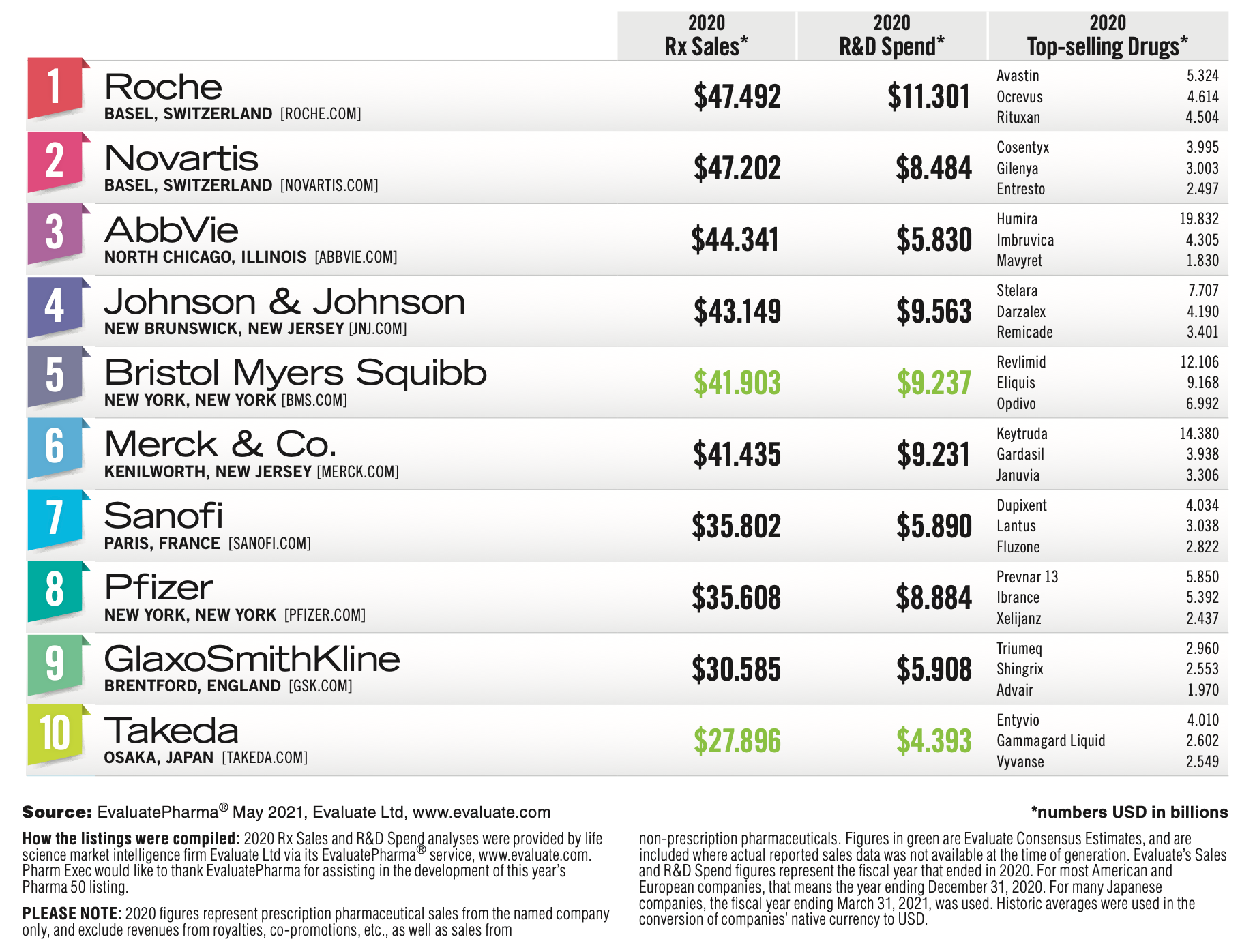
Roche repeated as well as biopharma’s top R&D spender, investing a total of $11.3 billion, an increase of 9.8% from the previous year. The company currently has 19 new compounds in Phase III clinical trials or filed for approval.
Rounding out the first five spots in our rankings are Novartis, once again at No. 2, up 2.4% to $47.2 billion; AbbVie, vaulting from eighth to third, with Allergan assets added to the books from the acquisition close date of May 8, 2020 (full-year Rx sales jumped 37% to $44.3 billion); Johnson and Johnson’s 7.7% growth in prescription drug revenue to move up two spots to No. 4 (flip-flopping with Merck); and Bristol Myers Squibb entrenched again in the fifth spot, behind a 3% Rx sales increase to $41.9 billion. For Novartis, its chronic heart failure (CHF) drug Entresto continues to make a steady climb up the market ladder, growing 45% in 2020 to $2.5 billion (sales of the medicine rose 34% in the first quarter of 2021). In February, it was granted an expanded label by FDA to include the majority of CHF patients—covering now adults with reduced ejection fraction or preserved ejection fraction. Novartis’s top-seller, the biologic Cosentyx, was approved earlier this month to treat plaque psoriasis in pediatric patients.
AbbVie still lays claim to the world’s highest-grossing product in immunology giant Humira, with sales just under $20 billion in 2020, but much attention has been paid recently to the drug’s looming biosimilars face-off (AbbVie’s patent expires in 2023) and the company’s corresponding strategy to offset future losses. Humira accounts for roughly 45% of AbbVie’s total drug sales, one of the largest such single-drug shares in big pharma. AbbVie is hoping its next-generation drugs Skyrizi and Rinvoq will help fill the gap post-patent. Approved for psoriasis and rheumatoid arthritis, respectively, the pair combined for $2 billion in sales in 2020. Executives, confident in their potential, reportedly maintain projections of $15 billion in sales for the duo in 2025. Skyrizi, an IL-23 inhibitor, is in late-stage testing for Crohn’s disease, psoriatic arthritis, and ulcerative colitis (reporting positive Phase III results in Crohn’s last month, meeting primary endpoints in two separate dosage trials). Rinvoq, a JAK inhibitor, is also pursuing indications in atopic dermatitis (beating placebo in three Phase III studies in data recently disclosed), ankylosing spondylitis, and psoriatic arthritis.
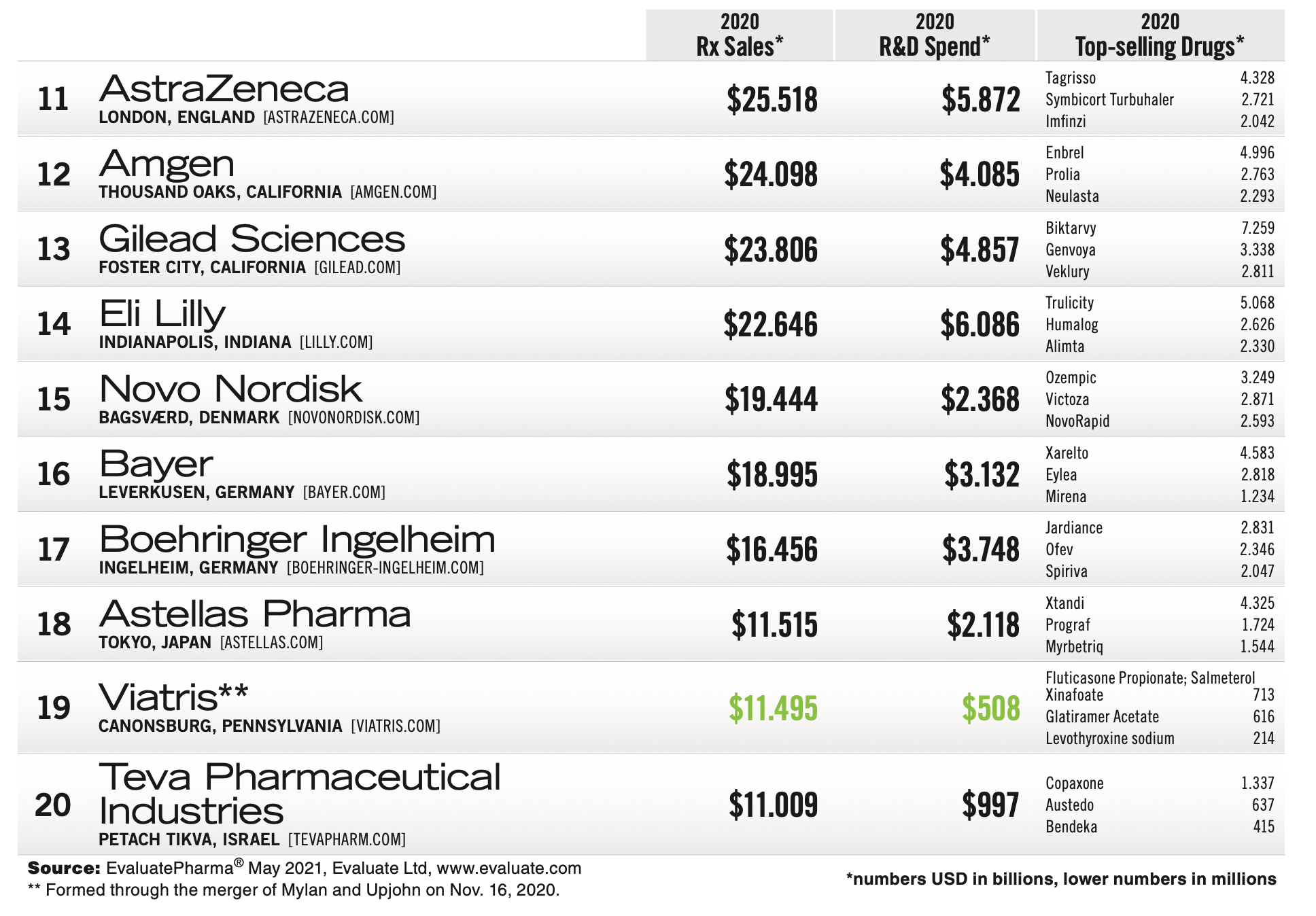
A pair of new regulatory approvals should position BMS for some gains in next year’s Pharma 50. Last month, FDA cleared Zeposia for adults with moderate-to-severe ulcerative sclerosis; it’s already marketed for relapsing forms of MS. Also in May, BMS’s blockbuster Opdivo ($7 billion in 2020 sales), a PD-1 inhibitor and rival to Merck’s Keytruda, was approved as an adjuvant for esophageal or gastroesophageal junction cancer. And in clinical testing, BMS’s experimental drug relatlimab has shown in combination with Opdivo to dramatically extend the time it took for advanced melanoma to worsen compared with Opdivo alone.
Click to enlarge

Click to enlarge

Click to enlarge
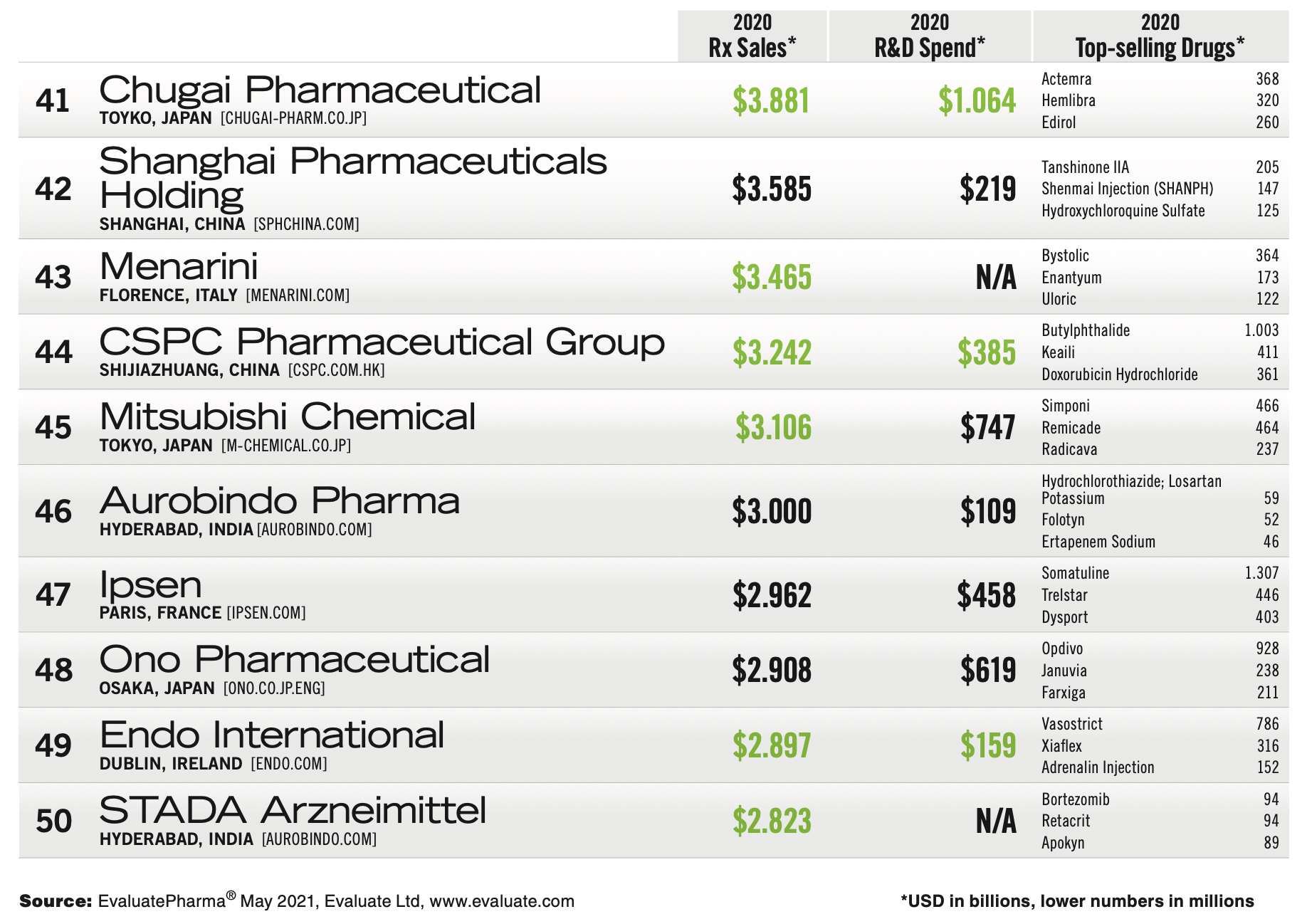
BMS spent an estimated $9.237 billion in R&D last year, ranking third in this metric behind J&J ($9.563 billion) and Roche. Rounding out the top five R&D spenders are Merck ($9.231 billion) and Pfizer ($8.884 billion), both of which notably have promising late-stage pneumococcal vaccines in the works. As far as Rx sales, Merck dropped two spots on our list, to sixth (though did post a 1.3% increase), and Pfizer, largely in the headlines the past several months for teaming with German biotech BioNTech to develop and make the first emergency use vaccine for COVID, dropped five spots to eighth. Sitting in-between is Sanofi, at seventh, with a 2.5% increase in revenue versus the previous year.
Manning the last two positions in the Pharma 50 top 10 are once again GlaxoSmithKline and Takeda. GSK, still planning to split the organization into two next year, recently announced plans to sell its complete stake in respiratory drug partner Innoviva (a royalty management company) for about $392 million. Takeda’s Rx revenue fell 4.6% last year, but the Japanese drugmaker is hopeful of potential reinforcements in the years ahead. Maribavir, a key asset in its $62 billion acquisition of Shire in early 2019, was granted priority review by FDA last month, and could become the only treatment for refractory post-transplant cytomegalovirus infection, the most common opportunistic infection in liver transplant recipients. Takeda is planning six regulatory filings in all this year, including a vaccine candidate for dengue fever.
It’s important to note, broadly, amid pandemic-related disruption, FDA actually approved more novel medicines in 2020—57—than in 2019. An Evaluate Vantage analysis uncovered fifth-year sales potential of $21.5 billion for those drugs, numbers comparable to pre-pandemic years. At the same time, Deloitte, in its new ROI of R&D Report, found that, of the 1,210 trials impacted by the pandemic from March-November 2020, the vast majority (66%) had delayed starts or completions, and 8% were terminated or stopped before enrolling any patients. Twenty-nine percent were in Phase III, which Deloitte notes could affect future asset launches and sales. Nevertheless, as IQVIA found in its own report, released in May, funding for early and late-stage R&D, as well as deals, increased significantly in 2020 regardless of COVID, with aggregate R&D spend for the top 15 companies reaching a record high.
Rest of field
Some highlights of note from the remainder of our rankings include an unfamiliar name in the 19th spot, Viatris, the new company formed after Mylan officially merged with Pfizer’s Upjohn; Vertex Pharmaceuticals leaping 13 spots, from 39th to 26th, with Rx sales up 49%, driven by cystic fibrosis newcomer Trikafta ($3.9 billion in 2020 sales); Regeneron moving up three spots to 28th behind drug revenue growth of 15%; and China’s Jiangsu Hengrui Medicine (38th) generating over $880 million more in Rx sales last year versus 2019. Newcomers to this year’s Pharma 50 include Chinese company CSPC Pharmaceutical Group (42nd) and India-based STADA Arzneimittel (50th).
Michael Christel is Pharm Exec’s Managing Editor. He can be reached at mchristel@mjhlifesciences.com
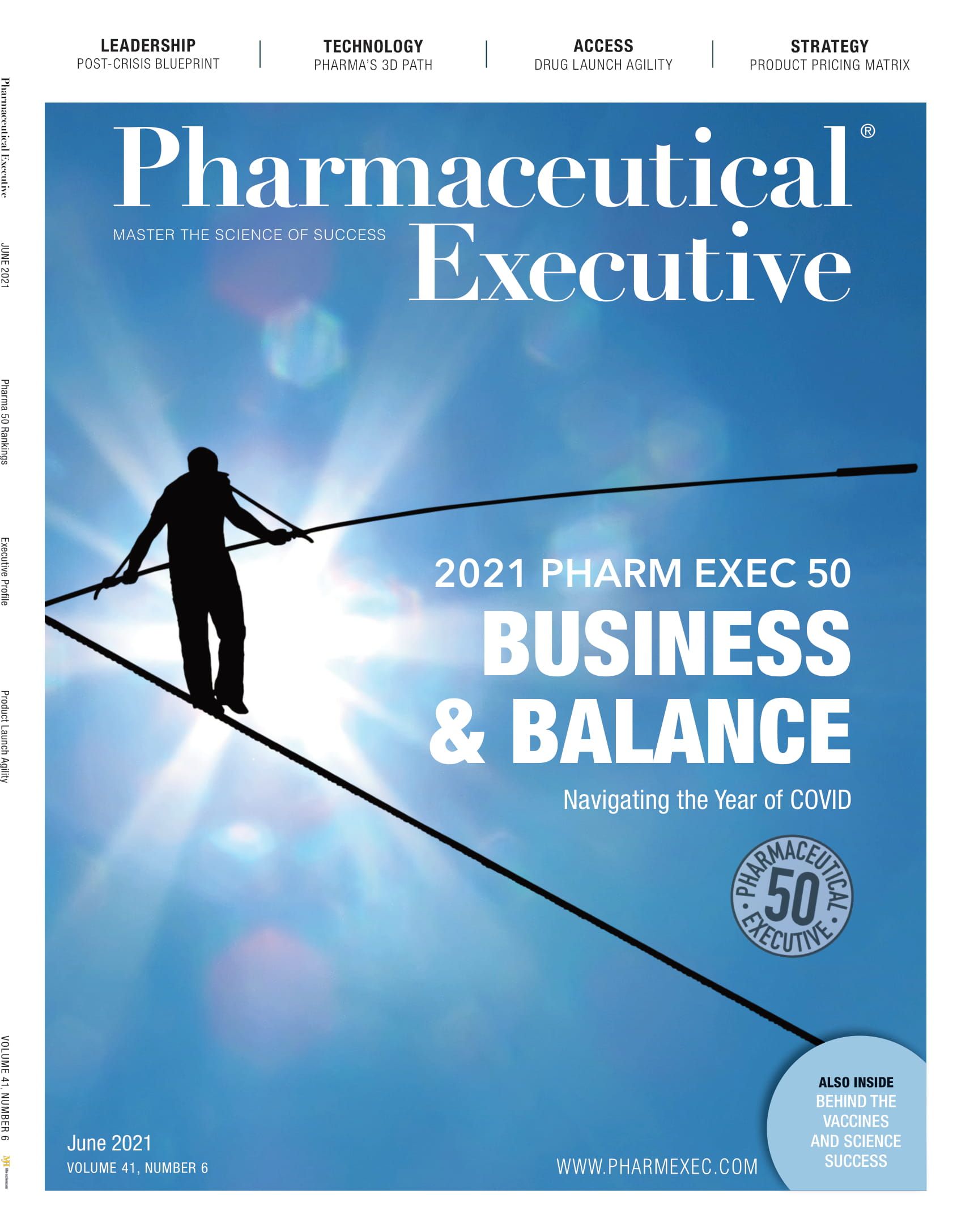
Cell and Gene Therapy Check-in 2024
January 18th 2024Fran Gregory, VP of Emerging Therapies, Cardinal Health discusses her career, how both CAR-T therapies and personalization have been gaining momentum and what kind of progress we expect to see from them, some of the biggest hurdles facing their section of the industry, the importance of patient advocacy and so much more.
